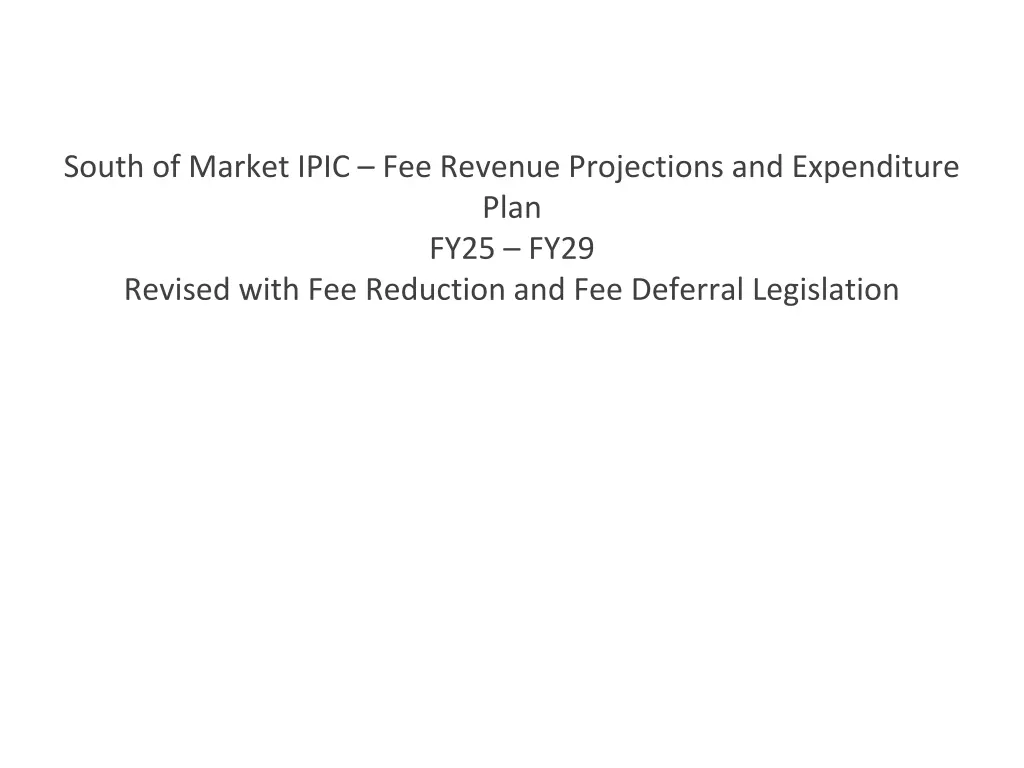
Development Impact Fee Legislation in San Francisco
Explore the revised fee revenue projections and expenditure plans in South of Market, San Francisco, along with the impact of fee reduction and deferral legislation on development projects. Learn about the slowing revenue trends, proposed funding adjustments, and the approved ordinance affecting development impact fees in the city from the detailed content provided.
Download Presentation

Please find below an Image/Link to download the presentation.
The content on the website is provided AS IS for your information and personal use only. It may not be sold, licensed, or shared on other websites without obtaining consent from the author. If you encounter any issues during the download, it is possible that the publisher has removed the file from their server.
You are allowed to download the files provided on this website for personal or commercial use, subject to the condition that they are used lawfully. All files are the property of their respective owners.
The content on the website is provided AS IS for your information and personal use only. It may not be sold, licensed, or shared on other websites without obtaining consent from the author.
E N D
Presentation Transcript
South of Market IPIC Fee Revenue Projections and Expenditure Plan FY25 FY29 Revised with Fee Reduction and Fee Deferral Legislation
June Meeting Reported slowing revenue over the next two to four years with revenue not catching up until year 5 (FY29) Ramifications: funding was proposed to be pushed out for programmed projects; only one moderate size projects added for funding
October Meeting Development Impact Fee Deferral and Reduction Legislation Development projects not moving forward due to infeasibility For housing fees, Technical Working Group convened to discuss reduction of housing fees and other measures Mayor s Office and Board President Peskin proposed additional development fee reductions to encourage construction
Development Impact Fee Deferral and Reduction Legislation Ordinance approved by the Planning Commission on July 13, 2023 Ordinance approved by Full Board on initial reading July 25, 2023 The Way It is Now 1. Impact fees are adjusted annually on January 1 by the Annual Infrastructure Construction Cost Increase Estimate (AICCIE), with the exception of the Inclusionary Housing Fee that is subject to a different adjustment methodology. 2. Once assessed for a given project, impact fees increase annually on January 1 until a first construction 3. Impact fees are due upon issuance of a first construction document. 4. All non-residential development projects are required to pay impact fees in all Zoning Districts.
Development Impact Fee Deferral and Reduction Legislation The Way It Will Be 1. Impact fees are adjusted annually on January 1 by the Annual Infrastructure Construction Cost Increase Estimate (AICCIE), with the exception of the Inclusionary Housing Fee that is subject to a different adjustment methodology. 2. Impact fees other than the Inclusionary Housing Fee would be locked-in at the amounts assessed upon project approval rather than continuing to increase every January 1 until the issuance of a first construction document. All non-residential development projects are required to pay impact fees in all Zoning Districts. 3. Payment of impact fees other than the Inclusionary Housing Fee could be deferred until first certificate of occupancy. This would reactivate and modify a program that sunset in 2013. 4. New retail and industrial projects in the City s PDR Zoning Districts, as well as projects with hotel, entertainment, bar, and open space uses in the City s C-2 Districts, would be exempt from paying impact fees for the next three years. 5. Fees would be reduced by 33% through FY29.
Ramifications Revenue reduced FY 24 and FY25 FY26-FY29 THROUGH FY 29 THROUGH FY 34 Previous Projections (June 2023) $ 1,914,000 $ 174,155,000 $ 239,094,000 $ 277,679,000 Revised Projections $ 863,000 $ 79,736,000 $ 146,639,000 $ 241,545,000 Difference $ (1,051,000) $ (94,419,000) $ (92,455,000) $ (36,134,000)
Ramifications Previous version of draft Expenditure Plan adjusted proposed expenditures to enable balanced budget at the end of five-year budget cycle to the extent possible All funding categories now show deficits at end of five-year funding cycle -> some projects unlikely to be funded IPIC did not want to adjust expenditures at this time in case funding picture improves in the next couple of years
Revised CFD Projections Previous Expenditure Plan did not include revised CFD Because of lingering projects, expectations of constructions starts (and thus fee payment) was pushed out for most large projects to FY27 and later Pushed out construction starts -> pushed out construction completions (Certificates of Occupancy) -> pushed out commencement of CFD tax payments -> no longer expecting ability to bond within the five-year planning cycle Greatly reduced CFD revenue within next five years: had been $100M +; now only about $500K
Revised CFD Projections IPIC proposing reducing those expenditure line items directly associated with revenue Regional Transit Capacity Improvements Environmental Sustainability & Resilience [placeholder] Cultural Preservation and Community Services [placeholder] Bessie Carmichael Supplemental Services
